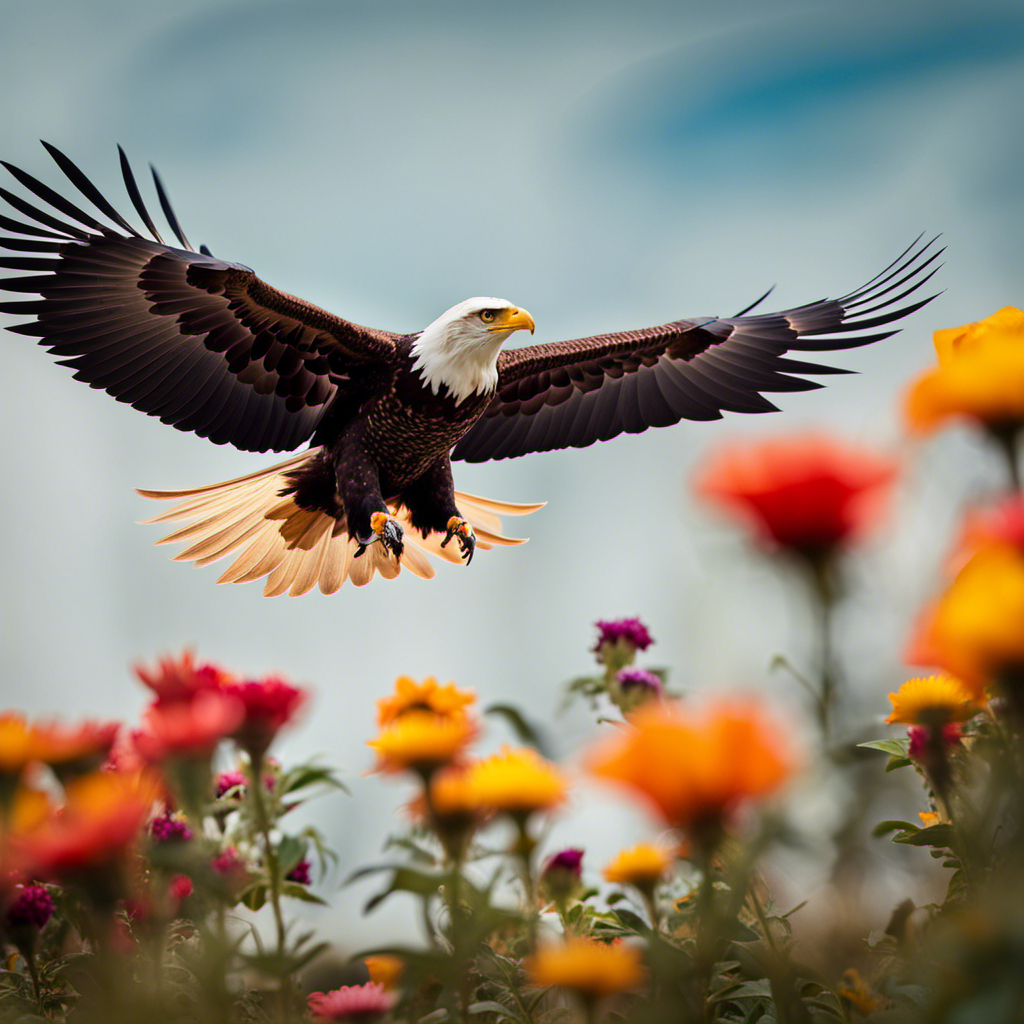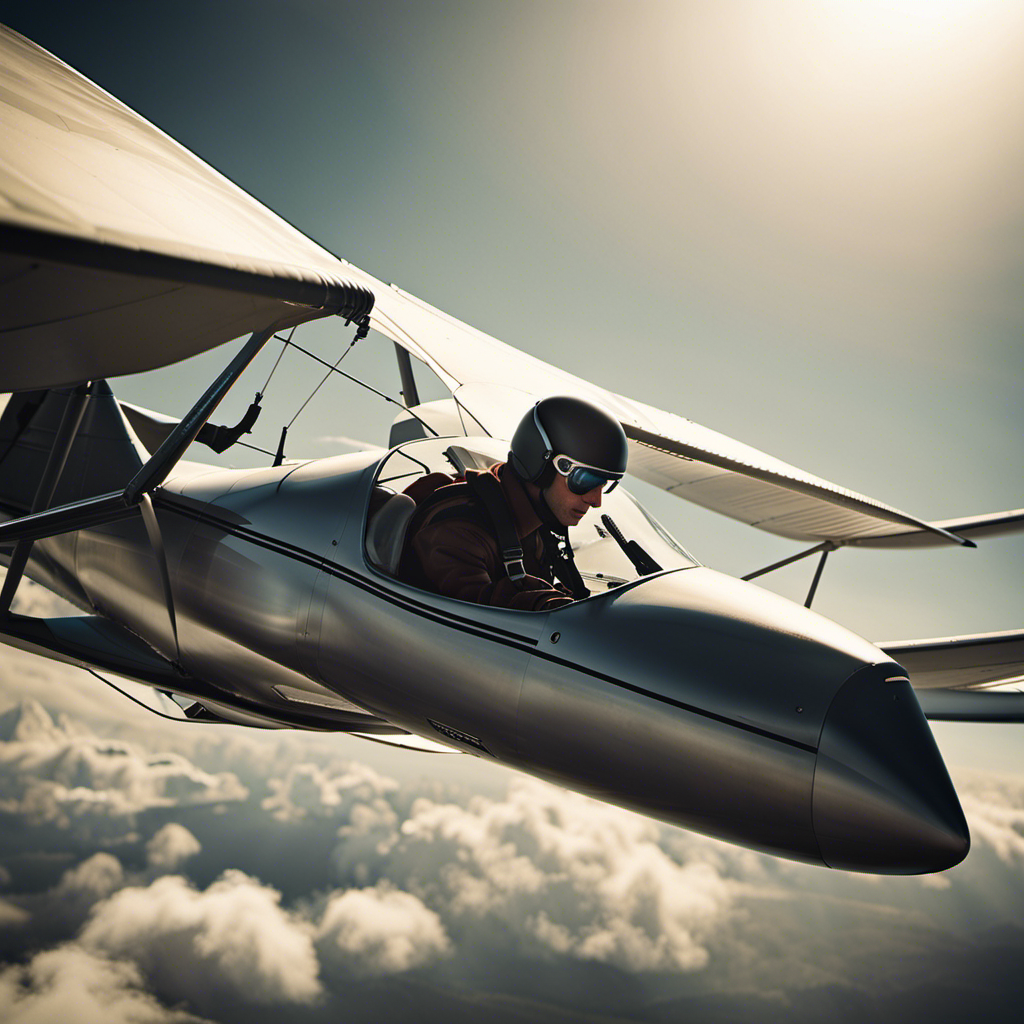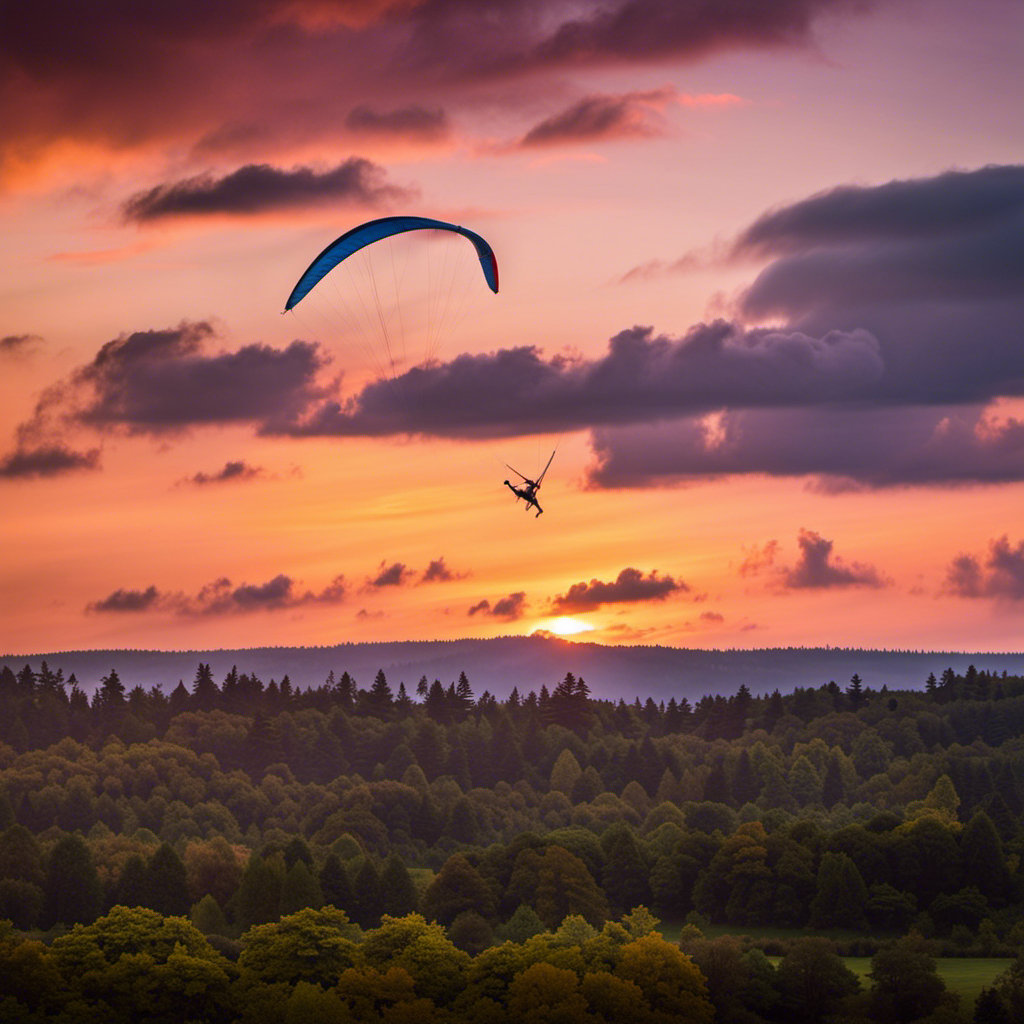Have you ever thought about the differences between gliding and soaring? Get ready to satisfy your curiosity. This article will delve into the technical aspects of these two types of flight.
You’ll learn how gliding and soaring work, the variations in flight patterns, the advantages and disadvantages of each, and even get to explore examples of birds that employ these techniques.
Prepare to be amazed by the beauty and complexity of gliding and soaring!
Key Takeaways
- Gliding and soaring are both adaptations for efficient flight in birds.
- Gliding involves utilizing updrafts and thermals, while soaring involves utilizing rising air currents.
- Gliding and soaring birds have specialized wings and bodies for efficient harnessing of air currents.
- Both gliding and soaring require skill and experience for accurate navigation and control of body position and wing adjustments.
The Basics of Gliding and Soaring
If you want to understand the basics of gliding and soaring, you should know that both involve flying without an engine.
Gliding is a form of flight where the aircraft maintains its altitude by using the energy from the surrounding air. It relies on gravity and the upward movement of air to stay in the air.
In contrast, soaring is a technique used by birds and some aircraft to stay in the air by using rising air currents, such as thermals and ridge lift.
The goal of gliding and soaring is to stay airborne for as long as possible by utilizing these natural sources of lift.
Understanding how gliding works requires knowledge of the aerodynamics involved and the various techniques used to exploit rising air.
How Gliding Works
Gliding works by using air currents to stay aloft. To understand how gliding works, it is important to consider the following:
-
Lift: Gliders generate lift by utilizing the shape of their wings and the movement of air over them. As the glider moves forward, the wings create an upward force that counteracts the force of gravity, allowing the glider to stay in the air.
-
Drag: Gliders experience drag, which is the resistance of the air against their forward motion. Minimizing drag is crucial for maintaining speed and efficiency during gliding.
-
Energy management: Gliders rely on efficient energy management techniques to sustain their flight. By utilizing rising air currents, such as thermals or ridge lift, gliders can gain altitude and extend their flight time.
Understanding how gliding works lays the foundation for comprehending how soaring, a more advanced form of gliding, operates.
How Soaring Works
To understand how soaring works, you need to master the art of catching and riding air currents. Soaring is a technique used by glider pilots to stay aloft without the use of an engine. It involves finding and utilizing rising air currents to maintain altitude and even gain height. These air currents can be generated by various factors such as thermal activity, ridge lift, or convergence zones.
To illustrate the different types of air currents used in soaring, consider the following table:
| Air Current | Description | Emotion |
|---|---|---|
| Thermal Lift | Warm air rising from the ground | Excitement, anticipation |
| Ridge Lift | Wind deflected upwards by a hill or ridge | Adventure, thrill |
| Convergence Lift | Two air masses colliding | Intrigue, curiosity |
Understanding these air currents and their emotional impact on pilots is crucial in mastering the art of soaring. With this knowledge, you can now explore the differences in flight patterns between gliding and soaring.
Differences in Flight Patterns
When it comes to gliding in straight lines, you’ll find that it involves maintaining a steady course without any changes in direction. This type of flight pattern requires minimal effort as you rely on gravity and air currents to maintain your forward momentum.
On the other hand, soaring in circles and spirals involves utilizing the surrounding air currents to gain altitude and maintain flight. By skillfully maneuvering in these patterns, you can maximize your time aloft and cover greater distances.
Gliding in Straight Lines
Birds can maintain a straight line while gliding due to their aerodynamic adaptations. These adaptations allow them to effectively utilize air currents and maintain stability during flight. Here’s how they do it:
-
Wings: Birds have long and narrow wings, which reduce drag and allow for efficient gliding. The shape of their wings creates lift and helps them stay aloft.
-
Feathers: Feathers play a crucial role in gliding. They provide a smooth surface that reduces air resistance and allows birds to glide effortlessly through the air.
-
Primary feathers: These are the long, sturdy feathers at the tips of the wings. They provide lift and control during gliding.
-
Secondary feathers: These feathers are responsible for controlling the bird’s direction and stability while gliding.
With these adaptations, birds can effortlessly maintain a straight line while gliding through the air.
Now, let’s explore how they transition into soaring in circles and spirals.
Soaring in Circles and Spirals
Now that you understand the principles of gliding in straight lines, let’s delve into the intricacies of soaring in circles and spirals.
Unlike gliding, which relies on gravity and air currents to maintain forward motion, soaring involves utilizing rising air masses to gain altitude and prolong flight.
When soaring in circles, you will carefully position yourself within a thermal, a column of warm rising air, to ascend. By flying in a circular pattern, you can continually access the upward currents, allowing you to stay airborne for extended periods.
Similarly, soaring in spirals involves maneuvering within a thermal while simultaneously ascending and traveling horizontally. The ability to master both circular and spiral soaring techniques is crucial for achieving maximum efficiency and endurance in your flight.
With the knowledge of these soaring techniques, we can now explore the importance of speed and efficiency in gliding and soaring.
Speed and Efficiency
The main advantage of gliding and soaring is that they require less energy. This allows birds to cover long distances without expending too much effort. When it comes to speed and efficiency, gliding and soaring have distinct characteristics:
-
Speed variations: Birds can adjust their speed during gliding and soaring depending on the air currents and their intended destination.
-
Energy conservation: By utilizing updrafts and thermals, birds can conserve energy by riding these currents instead of constantly flapping their wings.
-
Extended flight time: Gliding and soaring enable birds to stay airborne for extended periods, allowing them to search for food or mates over larger areas.
-
Enhanced maneuverability: Birds can make precise adjustments in their flight path by using different techniques, such as dynamic soaring or slope soaring.
These adaptations for gliding and soaring allow birds to optimize their flight efficiency and adapt to various environmental conditions.
Adaptations for Gliding and Soaring
Utilizing updrafts and thermals, you can conserve energy while gliding and soaring. Gliding and soaring birds have developed certain adaptations that allow them to take advantage of these natural phenomena.
To begin with, their wings are long and broad, providing a large surface area for lift. This enables them to ride the updrafts and thermals for extended periods of time. Additionally, their feathers are streamlined and lightweight, reducing drag and enabling efficient flight. They also have keen eyesight, allowing them to spot updrafts from a distance.
By using these adaptations, gliding and soaring birds are able to cover great distances while expending minimal energy.
Now, let’s explore the advantages and disadvantages of gliding.
Advantages and Disadvantages of Gliding
To conserve energy while gliding, you can take advantage of updrafts and thermals, allowing you to cover great distances with minimal effort. Here are some key advantages of gliding:
-
Increased range: By utilizing updrafts and thermals, you can extend your flight range and explore new areas without expending much energy.
-
Enhanced efficiency: Gliding allows you to maximize your flight time by minimizing the need for flapping or constant propulsion.
-
Quiet and peaceful flight: Gliding provides a serene and tranquil experience, as you glide effortlessly through the air without the noise and vibration associated with powered flight.
Advantages and Disadvantages of Soaring
If you want to cover long distances effortlessly and experience the tranquility of flight, soaring offers a unique and thrilling opportunity.
Soaring is a type of flight that relies on the use of rising air currents, known as thermals, to stay aloft. By circling within these thermals, birds can gain altitude and maintain their flight for extended periods of time. This method of flight is highly efficient, allowing birds to travel long distances without expending much energy. It also provides a sense of freedom, as birds can explore vast areas and navigate through challenging terrains.
However, soaring also has its disadvantages. Birds must constantly be on the lookout for thermals, and if they are unable to find one, they may be forced to land. Additionally, soaring requires skill and experience, as birds must learn how to accurately navigate and utilize the thermals.
Despite these challenges, soaring remains a remarkable feat of nature. Now, let’s explore some examples of gliding and soaring birds.
Examples of Gliding and Soaring Birds
Birds like hawks, eagles, and vultures effortlessly ride thermals and glide through the sky for hours at a time. To truly appreciate the beauty and complexity of gliding and soaring, consider the following:
- Birds use thermals, updrafts of warm air, to gain altitude and maintain flight.
- Gliding is the act of flying without flapping wings, using the momentum gained from a higher altitude.
- Soaring involves the use of wind currents and air pressure differentials to sustain flight.
- Both gliding and soaring allow birds to conserve energy and cover long distances.
- Different species of birds have specialized adaptations for gliding and soaring, such as wingspan and shape.
Understanding the intricacies of gliding and soaring enables us to marvel at the grace and efficiency with which these birds navigate the skies. Transitioning seamlessly, the next section will explore the conclusion: the beauty and complexity of gliding and soaring.
Conclusion: The Beauty and Complexity of Gliding and Soaring
You can truly appreciate the beauty and complexity of gliding and soaring when you witness the effortless way these birds navigate the sky.
Gliding is the act of flying through the air without flapping wings, using the natural air currents to stay aloft. It requires skillful control of body position and wing adjustments to maintain height and direction.
Soaring, on the other hand, involves utilizing rising air currents, such as thermals or ridge lift, to gain altitude and stay airborne for extended periods. Soaring birds, like hawks and eagles, have specialized wings and bodies that allow them to efficiently harness these air currents. They can soar for hours, covering vast distances without expending much energy.
The intricate dance between these birds and the elements is a sight to behold, showcasing the remarkable adaptability and mastery of flight in the animal kingdom.
Frequently Asked Questions
What are some common bird species that are known for their gliding and soaring abilities?
Common bird species known for their gliding and soaring abilities include the Red-tailed Hawk, Albatross, Turkey Vulture, and Golden Eagle. These birds utilize air currents and thermals to effortlessly navigate through the sky.
Are gliding and soaring techniques used by other animals besides birds?
Yes, gliding and soaring techniques are used by other animals besides birds. Bats, flying squirrels, and even some insects like butterflies and dragonflies have adapted to use these techniques for efficient movement through the air.
How do gliders and soaring birds navigate and find thermals or updrafts?
To navigate and find thermals or updrafts, gliders and soaring birds utilize their keen vision to spot subtle changes in air currents, as well as their ability to sense temperature gradients and wind direction. They adjust their flight path accordingly to maximize lift and stay airborne.
Can gliding and soaring be used as a form of transportation for humans?
Yes, gliding and soaring can be used as a form of transportation for humans. By harnessing thermals and updrafts, gliders and soaring birds can stay aloft for extended periods, covering great distances efficiently.
Are there any risks or dangers associated with gliding and soaring?
Yes, there are risks and dangers associated with gliding and soaring. These include turbulence, wind shear, bird strikes, mechanical failures, and pilot error. Proper training, equipment maintenance, and adherence to safety protocols can mitigate these risks.
Conclusion
As you reflect on the beauty and complexity of gliding and soaring, you can’t help but marvel at the contrasting elegance of these two flight patterns.
While gliding offers a sense of tranquility, soaring exudes a thrilling sense of freedom.
The precision and efficiency of each technique are truly remarkable.
From the graceful glide of the albatross to the majestic soar of the eagle, these birds showcase the mastery of flight.
Embrace the wonder of nature’s aerial ballet as you witness the juxtaposition of gliding and soaring in action.
With a heart that soars as high as the skies, Aria, affectionately known as “Skylark,” is the driving force behind Soaring Skyways. Her journey into the gliding world began as a young dreamer gazing up at the soaring birds, yearning to experience the weightlessness and freedom they embodied. With years of experience both in the cockpit and behind the scenes, Aria’s commitment to the gliding community is unwavering.










